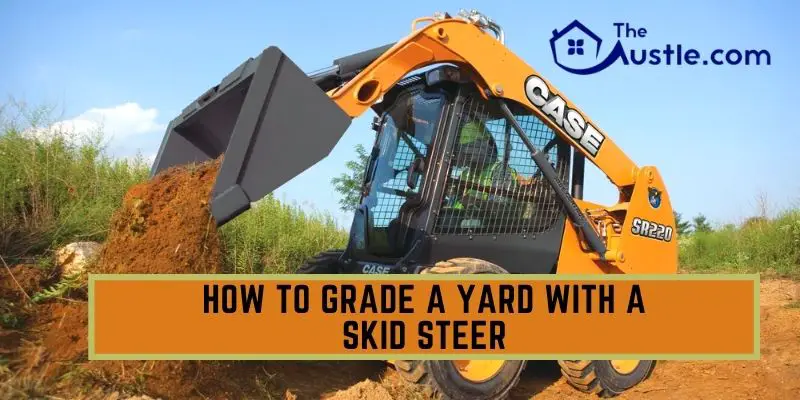Want to know how to grade a yard with a skid steer? The article provides you the best techniques to grade your yard. Grading a yard helps to provide good drainage, stability, and low maintenance in the future. If you decide to grade your yard, then first, you know what grading is?
Yard grading means leveling of the surface of the land. It helps to remove leaves, twigs, weeds, and rocks from the area. Sometimes, it requires to remove additional dirt. In this case, a skid steer is the best for doing the grading. You can do all types of works by skid steer.
Here, we give you the easy guidelines about grading a yard by using a skid steer.
How To Grade A Yard With A Skid Steer
An uneven yard can destroy beauty. Make your lawn more aesthetic, and you need to level it. You should be careful and keep patience during grading. Now, follow the below steps on how to grade a yard with a skid steer:
Step:1
Prepare your land for grading. You need to install fencing around the area where you want to level. It is temporary fencing that helps to prevent dirt and debris from escaping.
Step:2
If you are going to level the entire yard, then first remove the grass, weeds, etc. Or kill the weeds or grass with chemical herbicides. But if you do not want to grade your yard entirely, you need not remove the grass from the whole area. You mark the place where you want to level and apply topsoil to the lower ground by a skid steer.
Step:3
You should establish a spoils pile that can be used for moving debris for disposal. If you have a small farm, you can use this debris for other purposes. But, if not, you need to hire a dumpster to take it away.
Step:4
If you want to fill in a shallow area, you need to import topsoil. So, you must calculate how much extra soil you need.
Step:5
You must be aware of where you want to dig. Because there may have utility lines or pipes. Before grading, you must make sure that the area is free from pipes or utility lines.
Step:6
You may start working where the field is relatively level and close to your desired grade. To remove irregularities, you must lower the bucket attachment. Skid steer may bog down when you were working in very high areas. If this happens, you should back up and try again.
Step:7
When you finish clearing and rough grading, you may shoot grade elevations. After that, you may install grade stakes that instruct you to finish grading. Then, it would help if you had a leveling rod and a builders transit to get measurements.
Step:8
Set up a benchmark in the uppermost part of a nearby building and at the top of a patio or the floor inside of a house. The finished grade lies uniformly below or above the benchmark measurement. Then, you establish your benchmark and start shooting the grades in the entire work area. It will help you to know where you need to remove or add soil.
Step:9
Then, look at the whole area and jot down the measurements. Next, you should walk the grading area and calculate the rest of the measures. If your measurement is more extensive than the benchmark, then you need more soil. But if it is smaller than the reference, you need to reduce dirt.
Step:10
Then, you can use a bucket attachment to make the final grade. You may adjust the bucket so that the front is a little bit higher than the back, which helps you to scrape the grade using the back blade.
After doing this, you can see what you are doing for grading. It would help if you worked slowly to make slight adjustments and using the bucket to both spread and scrape the soil.
Why Skid Steer Is Better For Grading
When you use a farm tractor for leveling your yard, it does rough grading. The front bucket of this tractor uses to remove dirt from a high level and put it into a low level. But the main problem is that you still need a rake for smooth leveling your lawn.
But it does not happen when you use a skid steer. It has a wide array of attachments. It has a bucket that is used for rough grading and a grading attachment that helps to grade your lawn finely.
Tips
- You must level your yard in the spring, summer, or early fall. Because the ground may hard or frozen during late fall or winter.
- Always wear gardening gloves and safety clothes during working.
- You must fertilize your yard every year, keep it insect, and weed-free to make your lawn healthy.
- Grade your yard always 6 to 8 inches below the siding, if you are grading around buildings.
Conclusion
We think you find a more natural way to accomplish grading in your yard in this article. Leveling of a yard is not so difficult if you know how to grade a yard with a skid steer. It just requires some preparations. So follow the above steps and apply them.
- How To Change Hydraulic Fluid In Zero Turn Mower- Best Guideline With 2 Process
- How To Clear Underbrush In 3 Easy Steps
- How to Start an Excavating Business-7 Simple But Brilliant Idea
- How To Clean Weed Killer Out Of Sprayer- Easy Method With 3 Steps
- How to Refill Ortho Weed b Gon Hose End Sprayer as Home Guidance
- How to Overseed Bermuda Grass: Guidelines With 4 easy Steps
- How to Check Oil on Kohler Engine: Easy and Secured Way With 4 Steps

